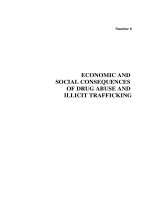Environmental, economic and social benefits of 3R approach in VN
Bạn đang xem bản rút gọn của tài liệu. Xem và tải ngay bản đầy đủ của tài liệu tại đây (858.75 KB, 10 trang )
Huynh Trung Hai
Institute for Environmental Science and Technology
`
Overview of agricultural waste generation and
it used in Vietnam
`
Policy background and the national strategy
on 3R in Vietnam
`
Opportunities for 3R approach on agricultural
waste management
`
Objectives
`
Main components and outputs projected
`
Related experiences of INEST
`
AArreeaa:: 331,900 km
2
`
PPooppuullaattiioonn:: 86.16 million
`
PPoopp.. ggrroowwtthh rraattee:: 1.18%
`
GGDDPP:: $87 billion
Ń
Agriculture
: 21.99%
Ń
Industry
: 39.91%
Ń
Service
: 38.1%
`
GGDDPP ggrroowwtthh rraattee:: 6.23 %
`
NNaattiioonnaall CCaappiittaall:: Hanoi
`
AAddmmiinniissttrraattiivvee ddiivviissiioonnss:: 63
provinces
Source: ,
WWaassttee ggeenneerraattiioonn 22000055
((MMtt))
22001100
((pprroojjeecctteedd))
((MMtt))
Agricultural residues (straw,
bagasse, com cob, casava,
straw, rice husk, peanut and
coffee husk, etc.)
60.82 72.37
Animal waste 54.72 60.72
Source: Vietnam-Germany Symposium on Renewable Energy, HUT 16 Oct. 2009
In rural areas, agricultural wastes are treated as:
- uncontrolled dumping Æ
pollution, CH
4
emission;
- a source of fuel
(reused);
- org. fertilizer, biomass, biogas Æ
recycling potential.
Sources: IET-VAST
`
HHaazzaarrddoouuss wwaasstteess: excess
fertilizers and pesticides
`
In 2008:
- 1.77 million tons of excess
nitrogenous fertilizers;
- 2.07 million tons of excess
phosphate fertilizers;
- 0.34 million tons of excess
potassium fertilizers.
`
Nearly 100% farming land
are fertilized
SSoouurrcceess
mmiilllliioonn ttoonnss
Paddy straw 61.9
Rice husk 5.6
Maize husk 4.8
Cassava stem 0.6
Cane trash 1.5
Bagasse 5.0
Peanut shells 0.1
Peanut leaves 5.7
Coffee husk 0.3
NNuummbbeerr ooff
aanniimmaallss
22000066 22000077 22000088
Pig 26,855,300 26,560,700 25,580,000
Cow 6,510,800 6,724,700 7,220,000
Buffalo 2,921,100 2,996,400 2,900,000
Poultry 214,600,000 226,000,000 241,000
Source: GSO, 2009
- Number of breeding farms in 2008 was 16,700 -
of which ~ 10% designed and equipped to treat their
animal wastes
- Biogas production of animal dung: 2.0 billion m
3
MMaatteerriiaallss
((
aaggrriiccuullttuurraall
wwaasstteess))
WWaassttee
ggeenneerraatteedd
((kkgg//aanniimmaall))
DDrryy ccoonntteenntt
((%%))
CC//NN BBiiooggaass oouuttppuutt
((lliitteerr//kkgg ooff
ffrreesshh mmaatteerriiaall))
Cow pat 15 ² 20 18 ² 20 24 ² 25 15 ² 32
Buffalo pat 18 ² 25 16 ² 18 24 ² 25 15 ² 32
Pig pat 1.2 ² 4.0 24 ² 33 12 ² 13 40 ² 60
Poultry 0.02 ² 0.34 25 - 50 5 ² 15 50 ² 60
Night soil 0.18 ² 0,34 20 - 34 2.9 ² 10 60 ² 70
Eichnoria
(fresh)
4 ² 6 12 ² 25 0.3 ² 0.5
Straw (dry) 80 - 85 48 - 117 1.5 ² 2.0
Source: Institute of Energy, 2008
`
The
33RR aapppprrooaacchh
in Vietnam has been emphasized
in umbrella policies:
- Viet Nam Agenda 21,
- National Strategy on Environmental Protection
to 2010 with vision toward 2020,
- Law on Environmental Protection 2005.
`
The National Strategy on Waste 3R to 2020 has
been being developed and
rreeaacchheedd ttoo tthhee 44tthh--
DDrraafftt::
TToo 22001155,, tthhee ggeenneerraall oobbjjeeccttiivveess aarree sseett::
Ń To improve the public awareness on 3R;
Ń Starting to form environmental friendly and energy saving
life of the society;
Ń To establish the infrastructure, finance and human
resource for 3R implement.
TThhee ssppeecciiffiicc ttaarrggeett uunnttiill 22001155::
Ń 80 % of solid waste will be collected;
Ń Reduce the generated rate of solid waste;
Ń The amount of solid waste that requires land filling and
incineration will be cut down to 70% of the total volume of
collected waste while 30% will be reused and recycled.
TToo 22002200,, tthhee ggeenneerraall oobbjjeeccttiivveess aarree sseett::
Ń To form sustainable production and
consumption society.
TThhee ssppeecciiffiicc ttaarrggeett uunnttiill 22002200::
Ń 95 % of solid waste will be collected;
Ń Reduce the generated rate of solid waste;
Ń The amount of solid waste that requires land
filling and incineration will be cut down to 40%
of the total volume of collected waste while 60%
will be reused and recycled;









